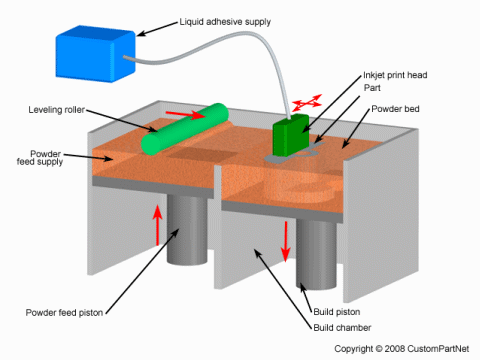- Processes
- Polymer Processing
- Blow Molding
- Injection Molding
- Metal Injection Molding
- Thermoforming
- Metal Casting
- Centrifugal Casting
- Die Casting
- Investment Casting
- Permanent Mold
- Sand Casting
- Shell Mold Casting
- Machining
- Milling
- Turning
- Hole-making
- Drill Size Chart
- Tap Size Chart
- Sheet Metal Fabrication
- Forming
- Cutting with shear
- Cutting without shear
- Gauge Size Chart
- Additive Fabrication
- SLA
- FDM
- SLS
- DMLS
- 3D Printing
- Inkjet Printing
- Jetted Photopolymer
- LOM
- Materials
- Metals
- Plastics
- Case Studies
- Cost Analysis
- Part Redesign
- Product Development
- Resources
- Curriculum Resources
- Glossary
Three Dimensional Printing (3DP)
technology was developed at the Massachusetts Institute
of Technology and licensed to several corporations. The
process is similar to the Selective Laser Sintering (SLS)
process, but instead of using a laser to sinter the
material, an ink-jet printing head deposits a liquid
adhesive that binds the material. Material options,
which include metal or ceramic powders, are somewhat
limited but are inexpensive relative to other additive
processes. 3D Printing offers the advantage of fast
build speeds, typically 2-4 layers per minute. However,
the accuracy, surface finish, and part strength are not
quite as good as some other additive processes. 3D
Printing is typically used for the rapid prototyping of
conceptual models (limited functional testing is
possible).
The 3D printing process begins with
the powder supply being raised by a piston and a
leveling roller distributing a thin layer of powder to
the top of the build chamber. A multi-channel ink-jet
print head then deposits a liquid adhesive to targeted
regions of the powder bed. These regions of powder are
bonded together by the adhesive and form one layer of
the part. The remaining free standing powder supports
the part during the build. After a layer is built, the
build platform is lowered and a new layer of powder
added, leveled, and the printing repeated. After the
part is completed, the loose supporting powder can be
brushed away and the part removed. 3D printed parts are
typically infiltrated with a sealant to improve strength
and surface finish.

Three Dimensional Printing (3DP)
Capabilities
Disclaimer: All process specifications reflect the approximate range of a process's capabilities and should be viewed only as a guide. Actual capabilities are dependent upon the manufacturer, equipment, material, and part requirements.
Return to top |